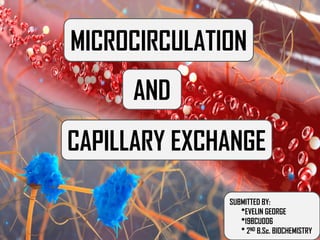
Microcirculation and Capillary exchange
- 1. MICROCIRCULATION AND CAPILLARY EXCHANGE SUBMITTED BY: *EVELIN GEORGE *19BCU006 * 2ND B.Sc. BIOCHEMISTRY SUBMITTED BY: *EVELIN GEORGE *19BCU006 * 2ND B.Sc. BIOCHEMISTRY
- 2. MICROCIRCULATION The microcirculation refers to the smallest blood vessels in the body: the smallest arterioles, the metarterioles, the precapillary sphincters, the capillaries,the small venules. Capillary exchange refers to the exchange of material between the blood and tissues in the capillaries. There are three mechanisms that facilitate capillary exchange: *diffusion, *transcytosis *and bulk flow.
- 3. DIFFUSION VS TRANSCYTOSIS VS BULK FLOW
- 4. CAPILLARY EXCHANGE MECHANISM Diffusion, the most widely-used mechanism, allows the flow of small molecules across capillaries such as glucose and oxygen from the blood into the tissues and carbon dioxide from the tissue into the blood. The process depends on the difference of gradients between the interstitium and blood, with molecules moving to low-concentrated spaces from high-concentrated ones. Transcytosis is the mechanism whereby large, lipid-insoluble substances cross the capillary membranes. The substance to be transported is endocytosed by the endothelial cell into a lipid vesicle which moves through the cell and is then exocytosed to the other side. Bulk flow is used by small, lipid-insoluble solutes in water to cross the the capillary wall. The movement of materials across the wall is dependent on pressure and is bi-directional depending on the net filtration pressure derived from the four Starling forces that modulate capillary dynamics.
- 6. FORCES AND PRESSURES INVOLVED The four Starling forces modulate capillary dynamics. Oncotic or colloid osmotic pressure is a form of osmotic pressure exerted by proteins in the blood plasma or interstitial fluid. Hydrostatic pressure is the force generated by the pressure of fluid within or outside of capillary on the capillary wall. The net filtration pressure derived from the sum of the four forces described above determines the fluid flow into or out of the capillary. Movement from the bloodstream into the interstitium is favored by blood hydrostatic pressure and interstitial fluid oncotic pressure. Alternatively, movement from the interstitium into the bloodstream is favored by blood oncotic pressure and interstitial fluid hydrostatic pressure.
- 8. CAPILLARY DYNAMICS Oncotic pressure exerted by proteins in blood plasma tends to pull water into the circulatory system. Due to the pressure of the blood in the capillaries, blood hydrostatic pressure is greater than interstitial fluid hydrostatic pressure, promoting a net flow of fluid from the blood vessels into the interstitium. However, because large plasma proteins, especially albumin, cannot easily cross through the capillary walls, their effect on the osmotic pressure of the capillary interiors will to some extent balance the tendency for fluid to leak from the capillaries. In conditions where plasma proteins are reduced (e.g. from being lost in the urine or from malnutrition), or blood pressure is significantly increased, a change in net filtration pressure and an increase in fluid movement across the capillary result in excess fluid build-up in the tissues (edema).
- 10. FUNCTIONS OF MICROCIRCULATION The principal function of the microcirculation are: Regulation of body temperature Transport of cell, oxygen, and other crucial substances. Substances involved include- * water, * electrolytes, *gases (O2, CO2), *nitrogenous wastes, *glucose, *lipids and *drugs.